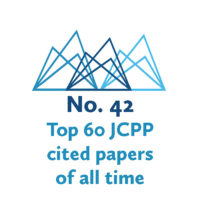Psychometrics
-

Depressive symptoms and loneliness among early adolescents: a psychometric network analysis approach
Open Access paper from the JCPP – ‘This study investigates: (a) the symptoms of depression that are connected to loneliness; (b) the role played by loneliness in the network of depression symptoms; and (c) whether the method used to measure loneliness (single-item direct or multi-item indirect) affects the relationship of loneliness with depressive symptoms’. Paweł Grygiel (pic) et al.
Read more -

Opportunities of measuring hierarchical models of psychopathology
Open Access paper from JCPP Advances – ‘I present two non-empirical arguments in favor of hierarchical models. […] I conclude by speculating that tests designed based on hierarchical models might help clinical assessment’. Erik Pettersson (pic).
Read more -

Most Cited JCPP Articles #5 of 60
Most cited JCPP papers #5 of 60: A CHILDRENS BEHAVIOUR QUESTIONNAIRE FOR COMPLETION BY TEACHERS – PRELIMINARY FINDINGS
Read more -

Most Cited JCPP Articles #16 of 60
Most cited JCPP papers #16 of 60: Development of the children’s eating behaviour questionnaire
Read more -

Most Cited JCPP Articles #17 of 60
Most cited JCPP papers #17 of 60: BEHAVIOR CHECKLIST FOR IDENTIFYING SEVERELY HANDICAPPED INDIVIDUALS WITH HIGH-LEVELS OF AUTISTIC BEHAVIOR
Read more -

Most Cited JCPP Articles #42 of 60
Most cited JCPP papers #42 of 60: Sensory Experiences Questionnaire: discriminating sensory features in young children with autism, developmental delays, and typical development
Read more -

Most Cited JCPP Articles #56 of 60
Most cited JCPP papers #56 of 60: Multicultural assessment of child and adolescent psychopathology with ASEBA and SDQ instruments: research findings, applications, and future directions
Read more -

Most Cited JCPP Articles #58 of 60
Most cited JCPP papers #58 of 60: Autism spectrum disorders at 20 and 42 months of age: Stability of clinical and ADI-R diagnosis
Read more -

Most Cited JCPP Articles #60 of 60
Most cited JCPP papers #60 of 60: Outcome at 7 years of children diagnosed with autism at age 2: predictive validity of assessments conducted at 2 and 3 years of age and pattern of symptom change over time.
Read more